| 16 November |
• yesterday • tomorrow |
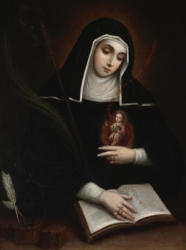
• Gertrude of Helfta
• Gertrudis Helfta
• Gertud von Helfta
• Geltrude
• Gertrudis la Grande
• Gertrude Magna
We don't know who her parents were or what became of them, and she may have been an orphan. Gertrude was raised in the Benedictine abbey of Saint Mary of Helfta, Eisleben, Saxony from age five. An extremely bright and dedicated student, she excelled in literature and philosophy, and when she was old enough, became a Benedictine nun. At age 26, when she had become too enamored of philosophy, she received a vision of Christ who reproached her; from then on she studied the Bible and the works of the Church Fathers. Gertrude received other visions and mystical instruction, which formed the basis of her writings. She helped spread devotion to the Sacred Heart of Jesus. Her writings have been greatly praised by Saint Teresa and Saint Francis de Sales, and continue in print today.
6 January 1256 at Eisleben, Thuringia (part of modern Germany)
• on a Wednesday of Easter season, 17 November 1302 at the convent of Saint Mary's of Helfta, Saxony (part of modern Germany) of natural causes
• relics in the old monastery of Helfta
received equipotent canonization, and a was universal feast day declared in 1677 by Pope Clement XII
• nuns
• Magdeburg, Germany, diocese of
• Naples, Italy
• West Indies
• crown
• lily
• taper, candle
• Exercises of Saint Gertrude
• Legatus Divinae Pietatis
• Liber Specialis Gratiae of Saint Mechtilde
May my soul bless you, O Lord God my Creator, may my soul bless you. From the very core of my being may all your merciful gifts sing your praise. Your generous care for your daughter has been rich in mercy; indeed it has been immeasurable, and as far as I am able I give you thanks. I praise and glorify your great patience which bore with me even though, from my infancy and childhood, adolescence and early womanhood, until I was nearly 26, I was always so blindly irresponsible. Looking back I see that but for your protecting hand I would haven been quite without conscience in thought, word or deed. But you came to my aid by giving me a natural dislike of evil and a natural delight in what is good, and provided me with necessary correction from those among whom I lived. To make amends for the way I previously lived, I offer you, most loving Father, all the sufferings of your beloved Son, from that first infant cry as he lay on the hay in the manger, until that final movement when, bowing his head, with a mighty voice, Christ gave up his spirit. I think, as I make this offering, of all that he underwent, his needs as a baby, his dependence as a young child, the hardships of youth and the trials of early manhood. To atone for all my neglect I offer, most loving Father, all that your only-begotten Son did during his life, whether in thought, word or deed. And now, as an act of thanksgiving, I praise and worship you, Father, in deepest humility for you most loving kindness and mercy. Though I was hurrying to my eternal loss, your thoughts of me were thoughts of peace and not of affliction, and you lifted me up with so many great favors. Finally, you drew me to yourself by your faithful promises of the good things you would give me from the hour of my death. So great are these promises that for their sake alone, even if you had given me nothing besides, my heart would sigh for you always and be filled with a lively hope. - from the Revelations by Saint Gertrude
O Sacred Heart of Jesus, fountain of eternal life, Your Heart is a glowing furnace of Love. You are my refuge and my sanctuary. O my adorable and loving Savior, consume my heart with the burning fire with which Yours is aflamed. Pour down on my soul those graces which flow from Your love. Let my heart be united with Yours. Let my will be conformed to Yours in all things. May Your Will be the rule of all my desires and actions. Amen. - Saint Gertrude
https://catholicsaints.info/saint-gertrude-the-great/

• Edmund of Abingdon
• Edmund of Canterbury
• Edme, Eadmund
Born to a wealthy and pious family, the son of Reinald and Mabel Rich; his father retired to become a monk, his two sisters became nuns. Studied at Oxford, England, and Paris, France. At Oxford he received a vision of the Child Christ. Priest. Professor of art, mathematics, philosophy and theology at Oxford. Known for his scholarship, piety, and skill as a preacher and writer. Canon of Salisbury, England in 1222. Preached the Sixth Crusade in England in 1227. Consecrated Archbishop of Canterbury, England on 2 April 1234. Advisor to King Henry III. Presided over Henry's ratification of the Magna Carta in 1237. Assisted in his public dealings by Saint Richard of Chichester. Prevented civil war in Wales. His support for monastic discipline put him in conflict with his own order, King Henry III, and the papal legate. He died while on a trip to Rome to gain the support of the Pope.
20 November 1175 at Abingdon, Berkshire, England
• 16 November 1240 at Soissy, Burgundy, France of natural causes
• interred at Pontigny, France
• shrine behind the high altar in the Cistercian abbey at Pontigny
1247 by Pope Innocent IV
• Abingdon, England
• Portsmouth, England, diocese of
• archbishop making a vow before a statue of the Blessed Virgin Mary
• embracing the Child Jesus
• placing a ring on the finger of a statue of the Blessed Virgin Mary
• receiving a lamb from the Blessed Virgin Mary
• with Saint Richard of Chichester
• with Saint Thomas a Becket
• Speculum Ecclesiae (Mirror of the Church)
• Provincial Constitutions
I have sought nothing else but you, O God. - Saint Edmund on his death bed
https://catholicsaints.info/saint-edmund-rich/

Margaret of Wessex
16 June in Scotland
Granddaughter of King Edmund Ironside of England. Great-niece of Saint Stephen of Hungary. Born in Hungary while her family was in exile due to the Danish invasion of England, she still spent much of her youth in the British Isles. While fleeing the invading army of William the Conqueror in 1066, her family's ship wrecked on the Scottish coast. They were assisted by King Malcolm III Canmore of Scotland, whom Margaret married in 1070. Queen of Scotland. They had eight children including Saint Maud, wife of Henry I, and Saint David of Scotland. Margaret founded abbeys and used her position to work for justice and improved conditions for the poor.
c.1045 in Hungary
• 16 November 1093 at Edinburgh Castle, Scotland, four days after her husband and son died in defense of the castle
• buried in front of the high altar at Dunfermline, Scotland
• relics later removed to a nearby shrine
• the bulk of her relics were destroyed in stages during the Protestant Reformation and the French Revolution
1251 by Pope Innocent IV
• against the death of children
• for learning
• parents of large families
• queens
• widows
• Dunfermline, Scotland
• Scotland
queen dispensing gifts to the poor, often while carrying a black cross
https://catholicsaints.info/saint-margaret-of-scotland/
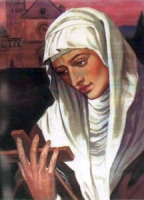
Daughter of Count Favorino Scifi and Blessed Hortulana, she was raised in a series of castles in and around Assisi, Italy. Younger sister of Saint Clare of Assisi, and her first follower, leaving home two weeks after Clare to join the Benedictines at San Angelo di Panzo at age fifteen. The family tried to bring Agnes back by force, dragging her from the monastery, but her body became so heavy that several knights could not budge her. Her uncle Monaldo tried to beat her, but was temporarily paralyzed. The family then left Agnes and Clare in peace.
In 1221 a group of Benedictine nuns in Monticelli asked to become Poor Clares, and Saint Francis assigned Agnes as their abbess. Agnes wrote about how much she missed Clare and the other nuns at San Damiano, and after establishing other Poor Clare monasteries in northern Italy, Agnes was recalled in 1253 when Clare was dying. Agnes followed Clare in death three months later.
1197 at Assisi, Italy
• 16 November 1253 at the monastery of San Damiano of natural causes
• buried in the Santa Chiara church, Assisi, Italy
• miracles reported at her tomb
1753 by Pope Benedict XIV (cultus confirmed)
Poor Clares
• young Poor Clare nun holding a book
• with Saint Clare of Assisi
• being dragged by her hair from a convent
https://catholicsaints.info/blessed-agnes-of-assisi/
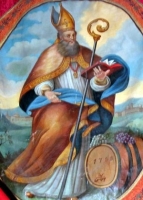
Audemar, Audomar, Otmar
Educated in the ancient provice Rhaetia, an area in modern Switzerland and Germany. Priest. Presided over a church of Saint Florinus in Rhaetia, probably the same church where Saint Florinus worked and was buried. Appointed abbot at Saint Gall, Switzerland in 720, and united the area monks into a monastery under the rule of Saint Columban. As abbot, he added a hospital and school, and changed the monastery's rule to Benedictine. Legend says that when Othmar fed the poor from a barrel of provisions, it never became empty, no matter how much he took from it.
In 759, Counts Warin and Ruodhart unjustly tried to gain possession of property belonging to the abbey. Othmar resisted, they imprisoned him at the castle of Bodmann, then on the island of Werd-on-the-Rhine where he died. His cultus spread soon after his death, and he is now one of the most popular saints in Switzerland.
• 16 November 759 at Werd-on-the-Rhine, near Echnez, Switzerland
• body transferred to monastery of Saint Gall in 769
• body entombed in the church of Saint Othmar at Saint Gall in 867
Benedictine abbot holding a barrel in his hand
https://catholicsaints.info/saint-othmar-of-saint-gall/
Avan, Avanus
Bishop. Nothing else is known about him for certain; various writers have made him a descendant of the 3rd century Cynedda Wledig, King of Britain, a cousin of 6th century Saint David of Wales, and the 10th century bishop Jeuan who was killed by Viking invaders, but no one today knows for sure.
The church dedicated to him at Lanafan Fawr, Powys, Wales was apparently a site of pilgrimages in times past, and site of at least one miracle. The English Lord Philip de Braose came to the area to hunt, and decided that the church was the best lodging for him and his dogs. When he woke at sunrise, his dogs had gone mad and he was blind. His sight was only restored by making his willingness to fight in the Crusades.
entombed in the churchyard of Saint Afan's Church, Lanafan Fawr, Powys, Wales
Llanafan remembers thee, O Hierarch Afan, thou teacher of piety, pastor, guide and inspirer of men's hearts. Wherefore, O holy one, entreat Christ our God that He will grant great mercy to our souls. - troparion of Saint Afan
https://catholicsaints.info/saint-afan-of-wales/
• 22 November as one of the Martyrs of England, Scotland and Wales
• 29 October as one of the Martyrs of Douai
Son of Thomas Osbaldeston. Studied at the English College in Douai, France, and then at the seminary in Rheims, France. Ordained on 21 September 1585. On 27 April 1589 he returned to England to minister to covert Catholics. Had a great devotion to Saint Jerome. Betrayed by Thomas Clark, an apostate priest, he was arrested at an inn in Tollerton, Yorkshire on 30 September 1594. Tried for high treason by reason of being a priest, he was quicklly condemned. Martyr.
c.1560 in Osbaldeston, Lancashire, England
hanged, drawn and quartered on 16 November 1594 at York, North Yorkshire, England
22 November 1987 by Pope John Paul II
https://catholicsaints.info/blessed-edward-osbaldeston/
Symeon
Fourth abbot of the abbey of Cava dei Tirreni in Campania, Italy. Elected in 1124, he served for 16 years of great political turmoil between state and Church; his rule was noted for his concern for the local laity under the abbey's protection, and for the works of the monks he sent out to reform other houses. Held in high esteem and sought out consellor by bishops, fuedal lords, King Roger II, Pope Anacletus II and Pope Innocent II.
• 16 November 1140 at Cava dei Tirreni monastery, Campania, Italy
• buried in Arsicia cave with other abbot of Cava dei Tirreni
• relics enshrined at the altar of Saint Benedict in the monastery church in 1928
18 May 1928 by Pope Pius XI (cultus confirmation)
Castellabate, Italy (proclaimed on 6 April 1963)
https://catholicsaints.info/blessed-simeon-of-cava/
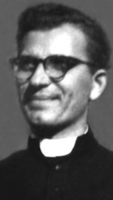
Josef Marxen
Studied in Vienna, Austria, and ordained in Munich, Germany on 21 June 1936 as a priest for the diocese of Lezhë, Albania. Arrested in Shijak, Albania in February 1945 for remaining Catholic following the Communist take over. Sentenced to prison where he was eventually murdered. Martyr.
5 August 1906 in Worringen, Cologne, Germany
shot on 16 November 1946 in the high security prison in Tiranë, Albania
• 5 November 2016 by Pope Francis
• beatification celebrated at the Square of the Cathedral of Shën Shtjefnit, Shkodër, Albania, presided by Cardinal Angelo Amato
https://catholicsaints.info/blessed-zef-marksen/
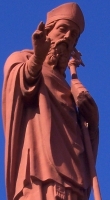
Born to the nobility, well educated, and known for his learning and as a gifted speaker. Married to Galla, who became a nun in later life; father of at least two sons – Saint Veranus of Vence and Saint Salonius of Geneva. In 422 he became a monk at Lérins, France, and Galla became a nun. Wrote works on asceticism. Reluctant bishop of Lyons, France in 434. Presided over the Council of Orange in 441. Worked with Saint Hilary of Arles.
449 of natural causes
https://catholicsaints.info/saint-eucherius-of-lyon/
Fifth century bishop of Asti, Italy. Little information and survived, and historians don't agree on any of it.
• buried in the crypts under the cathedral of Saint John in Asti, Italy
• re-interred in the church of San Sisto in Asti in 1567
• when the church became structurally un-sound the relics were enshrined in an urn beneath the high altar of the Cathedral of Santa Maria Assunta in Asti on 12 August 1696
https://catholicsaints.info/saint-anianus-of-asti/
Leocadius, Leucadio
23 November (Bourges, France)
Father of Saint Ludre. Imperial Roman senator in Déols, Gaul (in modern France). A pagan, he converted to Christianity in the early 4th century, brought to the faith by Saint Ursinus of Bourges, brought in missionaries to his area, supported Ursinus, and converted his own house into a church for their use.
https://catholicsaints.info/saint-leocadio-of-deols/

Gobrien
Breton monk. Priest. Bishop of Vannes, France. At age 87, he retired from his see to live his remaining days as a hermit. Known for healing by prayer.
• 725 of natural causes
• interred in the Chapelle de Saint Gobrien, Saint-Servant, France
https://catholicsaints.info/saint-gobrain-of-vannes/
Feast permitted by a 1679 decree of the Sacred Congregation of Rites for all provinces of Spain, in memory of the victories obtained there over infidels. Pope Benedict XIII granted it to the Papal States and it may now be celebrated with due permission by churches throughout the world.
https://catholicsaints.info/feast-of-the-patronage-of-our-lady/
Aelfric, Alfrick
Benedictine monk of Abingdon Abbey, England. Abbot of Abingdon. Bishop of Wilton, England. Archbishop of Canterbury, England in 995. It was during his governance that Kent was invaded by Danes.
1005 of natural causes
https://catholicsaints.info/saint-alfric-of-canterbury/
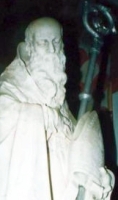
Fidenzio
Third bishop of Padua, Italy, serving from 166 to 168.
• Megliadino San Fidenzio, Italy
• Polverara, Italy
https://catholicsaints.info/saint-fidentius-of-padua/
1 November (Jerome Martyrology)
Lusor, Lusore
Son of Saint Leocadio of Déols. A convert, he died almost immediately after baptism, still wearing the white robes.
relics at Déols on the Indre (in modern Bourges, France)
https://catholicsaints.info/saint-ludre/
Official in the court of Emperor Constantius. He was demoted from the court by Julian the Apostate. Martyr.
dragged by wild horses and then burned at the stake in 362
https://catholicsaints.info/saint-elpidius-the-martyr/
Afrique of Comminges
Seventh century bishop of Comminges, France.
relics and shrine destroyed by Calvinists in the 16th century
https://catholicsaints.info/saint-africus-of-comminges/
Raised in a pagan family. Convert, baptized at Bordeaux, France where she became an evangelist.
Corneilhan, France
490 of natural causes
https://catholicsaints.info/saint-ceronne/
Martyr.
dragged by wild horses and then burned at the stake in 362
https://catholicsaints.info/saint-marcellus-the-martyr-16-november/
Augustine
Martyred in the persecutions of Decius.
c.250 in Capua, Campania, Italy
https://catholicsaints.info/saint-agostino-of-capua/
Felicity
Martyred in the persecutions of Decius.
c.250 in Capua, Campania, Italy
https://catholicsaints.info/saint-felicita-of-capua/
Martyr.
dragged by wild horses and then burned at the stake in 362
https://catholicsaints.info/saint-eustochius-the-martyr/
A group of North African Christians murdered together for their faith, date unknown. We know little more than their names - Baricus, Donatus, Honoratus, Januarius, Justus, Markus, Paulus, Rufinus, Valerius, Victor and Vitalis.
https://catholicsaints.info/martyrs-of-africa-16-november/
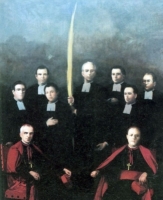
Soon after the start of the Spanish Civil War in 1936, the Communist-oriented Popular Front had all clergy and religious arrested and abused as they considered staunch Christians to be enemies of the revolution. Many of these prisoners were executed for having promoted the faith, and this memorial remembers several of them killed in the province of Almeria.
• Adrián Saiz y Saiz
• Bienvenido Villalón Acebrón
• Bonifacio Rodríguez González
• Diego Ventaja Milán
• Eusebio Alonso Uyarra
• Isidoro Primo Rodríguez
• Justo Zariquiegui Mendoza
• Manuel Medina Olmos
• Marciano Herrero Martínez
10 October 1993 by Pope John Paul II
https://catholicsaints.info/martyrs-of-almeria/
• Our Lady of Ostra Brama
CatholicSaints.Info Portable Edition